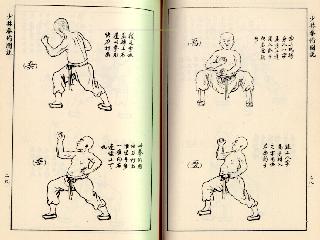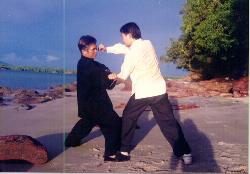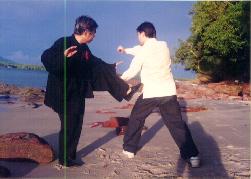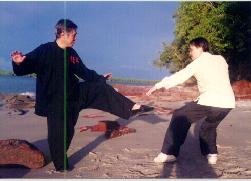SELECTION OF QUESTIONS AND ANSWERS
NOVEMBER 1999 PART 3

A page from an old kungfu classic showing the Shaolin Five Animals
Question 1
My question is about the Five-Animal Set. I have only found vague references to sets and forms which are based on a specific animal of the five, such as the White Crane form. I recollect that historically monks of Shaolin were taught perhaps one or two animal forms or sets best suited to their overall personage, and that no one monk was ever taught all five forms.
— Damian, USA
Answer
This was not true. The Five-Animal Set was an ancient Shaolin kungfu set complete by itself; it was not a composite set made up of patterns drawn from five different sets.
In fact the reverse process was true. From the Five-Animal Set, other sets developed that specialized on only one animal, such as the White Crane Set or the Black Tiger Set. Then a whole kungfu style was built around a specialized set, such as White Crane Kungfu, Black Tiger Kungfu, Dragon Style Kungfu, and Snake Style Kungfu. There was, however, no established Leopard Style Kungfu.
Nevertheless, one should note that it did not mean a specialized style had only patterns of that particular animal. In other words, in White Crane Kungfu, for example, there are also patterns of the dragon, snake, tiger and leopard, but crane patterns predominate.
Moreover, it is not true that a kungfu exponent who knows all the five animals is necessarily better than another who knows only one animal. In other words, if you know the Five-Animal Set or know five different sets each of one different animal, you are not necessarily a better fighter than one who knows only any one animal set. Indeed, again the reverse is often, but not always, the case. Students initially learn all the five animals. When they have reached a master's level, they often choose only one animal to specialize in.
Question 2
I have been unable to find information about any of these forms pertaining to their individual characteristics (i.e. what differentiates a tiger set from a dragon set), patterns (how do stances and movements differ from animal to animal), or even walk-through demonstrations, written or visual (what comprises each of these sets).
Answer
There is actually quite a lot of information on what you sought, but much of it is in Chinese. You can get some information in English from my books, "Introduction to Shaolin Kungfu" and "The Art of Shaolin Kungfu".
Obviously, a tiger set differs from a dragon set in that the sets are composed of mainly tiger patterns and dragon patterns respectively. Tiger patterns differ from dragon patterns in both their outward form and inner significance. Tiger patterns use the tiger-claws, for example, and focus on internal force, whereas dragon patterns use the dragon hand-form, and focus on mind.
The performance of a tiger set is characteristically different from that of a dragon set; any master can easily tell one from another. The names of the patterns as well as the crucial points of a set are often recorded in poetic language, but if you have not trained in the set you probably will understand nothing even if you were given the writing.
Question 3
And if there are individual sets for each animal, does this lead to the idea that the Five Animal Form is a cohesive blend of the most important and effective parts of each animal set?
Answer
There are many individual sets for each animal, and each set, unless it was composed for specific purposes, is self-contained. This mean by practising any one animal set well, you will be able to handle all combat situations.
With this understanding, you would realize that your question about the Five-Animal Set being a cohesive blend is irrelevant. The answer to your question can be yes, no, yes and no, and neither yes nor no, depending on numerous variables.
The answer is yes if you consider that the most important features of each animal is found in the Five-Animal Set. The answer is no if you consider that the Five-Animal Set came before, not after, the individual animal sets.
Question 4
Again, please excuse my ignorance, but my sources on the Five Animal Form do not mention this aspect, and I'm beginning to assume the reasons might be that this idea is accepted as common knowledge. If it is not too much to ask, any information or source material would be greatly appreciated.
Answer
There is no information because you made a wrong assumption that the Five-Animal Set was the result of blending the best of five individual animal sets.
The following comments will be more useful to you than information on source material. Your questions and concerns are typical of an educated Westerner, and contrasts sharply with Eastern philosophy on kungfu training. In a typical kungfu setting in the past, if a student were to ask his master these questions, the master would ask him to shut up and go on with his training.
Many Westerners, with a different mental frame, would think the master unsympathetic and uncaring. It was just the reserve. Because the master was sympathetic and caring, he did not want his student to waste his time over academic issues which would not bring any benefit to him in his kungfu training. He wanted his student to become a good kungfu exponent, not a historian or a debater.
If you review your questions, you will find that it does not matter much which way the answers go. Earlier you mentioned that you had a healthy respect for these arts and would not want to dishonour them. The best way to respect these arts is to practise them the way the masters would want you to practise, i.e. seek a real master and practise, practise and practise what he asks you to.
A sure way to dishonour them is, without wanting to be disrespectful, to imagine yourself smarter than all the past masters by philosophizing (which in the modern Western context actually means speculating) on matters that the masters themselves did not care about, and when you had not actually practised the arts.

Goh Kok Hin attacks Sifu Wong's right temple with a horn punch.
Question 5
I am currently taking up Tai Chi Chuan classes. My seniors have all been really good to me and the class is really united in togetherness. Of late however, I am acutely aware that I am practising Tai Chi dance. My sifu does not mention much of chi in the Tai Chi moves. Instead, she pays great attention to minor details of the Tai Chi form. I guess this is because she is after all a Tai Chi competitor and a competition trainer.
— Chen, Singapore
Answer
This is the norm. More than 75% of Tai Chi practitioners today, including in China, performs Tai Chi dance, and not Tai Chi Chuan.
Tai Chi dance is not without its benefits, otherwise it would not be so popular. Its benefits, of course, are those of dance and gentle exercise, such as socialization, recreation, graceful movements and relaxation, and not those of an internal martial art, like internal force and combat efficiency. In today's world, perhaps these benefits of dance and gentle exercise are more meaningful and needed than those of an internal martial art.Question 6
I was also shocked that she would never get to the self-defence of Tai Chi Chuan anytime at all. She has plans for the class to learn 32 Chen style Tai Chi sword, 42 Yang style and 42 Tai Chi competition routine after that. Hence, I have been on the lookout for Tai Chi Chuan or Baguazhang masters, hoping to learn complete arts.
Answer
Most probably she does not know anything about self-defence. Please don't embarrass her by reminding her, especially in public, that Tai Chi Chuan is a martial art and then asking her how she would use her Tai Chi to defend herself from a karate punch or a taekwondo kick.
Appreciate her for what she is. She has taught you beautiful Tai Chi forms which will provide you good foundation when you have the opportunity to meet a master who teaches Tai Chi Chuan as an internal martial art.Question 7
This becomes really embarrassing when my friends ask me if I am anywhere near self-defence for Tai Chi Chuan. I don't even have the chi for it, it goes without saying that self-defence is absent.
Answer
The same situation often looks different when viewed from a different perspective. You should consider yourself lucky. You are one of the few who know, at least theoretically, the difference between Tai Chi Chuan and Tai Chi dance; more than 75% of Tai Chi practitioners do not even know they are performing a dance.
Instead of being embarrassed, you should be proud of yourself. You realize your weakness and are seeking ways to overcome it. Just tell your friends that while searching for a master who teaches Tai Chi Chuan as an internal martial art, you are making the best of what you can, and you are benefiting from it, which is true.
Question 8
Not wanting to waste my time only on forms, I decided to do some zhan zhuang from your book. I know it will not have the same effect as having a master's supervision, but at least I will be able to do something to aid me in my future endeavours. Besides, my sifu has shown us the positions for some zhan zhuang too.
Answer
This is a good idea. Immediately after zhan zhuang, perform your Tai Chi movements. Do not worry about the correctness of your form, but put your mind in your movements and enjoy them. Just do what I have just said, i.e. put your mind in your movements and enjoy doing your movements. Breathe naturally, and do not use any strength.
Immediately after performing your set of Tai Chi movements, stand upright and relax — this is the Wuji Stance. Do not think of anything, and do not do anything. Just let go and relax. Soon you will find chi flowing inside you and swaying you.You may not find this chi flow the first time performing this sequence, nor the second, but if you persist for some time, which may be a few days or a few weeks, you will eventually experience the chi flow. If you just practise this sequence every day for a year, you will have attained a level of power and stamina better than most blackbelts in karate and taekwondo.
You still cannot defend yourself yet, for combat applications need to be trained differently, but you would have developed the necessary internal force for that purpose when the right master appears, as well as for daily work and play.
Sifu Wong shiftly moves to Goh's left side and kicks at Goh's ribs
Question 9
My mother said that I should not shower right after doing zhan zhuang, and that there were even special precautions to take when urinating and excreting after performing zhan zhuang. There should also be no eating before and after zhan zhuang. I am doubtful of this, since I have never seen this mentioned in the books I read.
Answer
Your mother is correct. These precaustions are usually given for chi kung practice in general, and zhan zhuang is powerful chi kung. It is advisable to leave at least about fifteen minutes before and after zhan zhuang and other forms of chi kung for activities like having a shower, urinating, excreting, and eating. Some masters advise a gap of an hour.
Question 10
Secondly, my mother insists that Tai Chi beginners should start of with dynamic chi kung like Ba Duan Jin, etc. I don't know this is true, but so far I know Tai Chi Chuan uses Tai Chi Stance and Chen style uses Chan Ssu Jing. Do I really have to learn sets of dynamic chi kung if I am to be proficient with Tai Chi Chuan?
Answer
Tai Chi Chuan itself is chi kung. Hence it is not necessary to practise other forms of chi kung. But when the chi or energy aspect is neglected in Tai Chi practice, many instructors employ other types of chi kung, such as dynamic chi kung like Ba Duan Jin, or quiescent chi kung like various forms of zhan zhuang as supplement. Dynamic or quiescent chi kung can be performed before or after performing Tai Chi external forms.
All styles of Tai Chi Chuan, including the Chen style, use the Tai Chi Stance, or the Three-Circle Stance. Technically speaking, Chan Ssu Jing is not a form of chi kung, but an application of chi kung. In other words, one can practise any kind of chi kung, including non-Tai Chi chi kung, and if he knows the technique he can apply Chan Ssu Jing, or spiral force.
Question 11
Can you tell me the best course of action I should take to further my mediocre internal art studies? Also, does your Shaolin Institute hold regular classes for Tai Chi Chuan? Thanks a lot Wong Sifu. If opportunity allows, I hope to be under your class someday and learn all the marvellous ways of Tai Chi self-defence.
Answer
The best course of action is to seek a genuine master and learn from him.
Instead of regular classes, I offer intensive courses which have proven to be more beneficial than regular classes for foreign students.

Goh Kok Hin moves his left leg backward but still in front of his
Question 12
At our school we never do any serious sparring because my instructor believes doing set practice will give us a better understanding of the techniques.
— Jason, USA
Answer
I strongly disagree with your instructor's view. Set practice enables you to perform kungfu techniques correctly and develop certain combat skills, but without sparring practice you can never be competent in self-defence.
Even practising sparring sets (where whole sets consist of pre-arranged sparring patterns between two or more persons) is insufficient. In other words, if you only do set practice you may understand the techniques in theory, but if you are caught in a combat situation you will be unable to use the techniques in actual fighting.
Question 13
What are your thoughts on sparring and the use of boxing gloves while sparring ?
Answer
To be able to swim, you must practise swimming; to be able to play football, you must practise playing football. To be able to spar, you must practise sparring. If you just learn swimming techniques on land, or learn football techniques in a classroom, but without practising the techniques in a pool or a field, you will never be able to swim or play football.
Similarly if you just learn kungfu techniques in set practice, but without practising the techniques in sparring, you will never be able to use the techniques to fight, although you may understand their uses theoretically and be able to demonstrate them beautifully in solo performance to please spectators. Past masters called such kungfu demonstrative forms “flowery fists and embroidery kicks”.
From my experience, I can reasonably say that instructors or even “masters” who teach sparring with the use of boxing gloves, cannot competently apply their kungfu techniques for combat. They and their students usually spar or fight like Western boxers or kickboxers.
I wonder if you have seen any kungfu or wushu sparring competitions, now called “san-da” in Chinese. They are a disgrace to the art. These competitors punch and kick like boxers, and bounce about the ring like boxers, having thrown kungfu features like the tiger-claw or the bow-arrow stance to the winds.
Question 14
How much time do you recommend that I should spend on forms and set practise compared to sparring ?
Answer
You should spend at least 50% of the time on not just sparring, but sparring using kungfu techniques. This cannot be learnt from books or videos; it has to be taught and guided by a competent instructor.
You may have learnt various kungfu techniques well in set practice and think that you know their combat application, but it is only in sparring that they come to life, and you will be amazed at the beauty and efficiency of kungfu techniques in comparison to straight-forward punching, kicking and blocking.
Question 15
How much time do your students spend on sparring compared to set practice and do they use boxing gloves and other such protective gears?
Answer
About 30% on set practice and 70% on sparring. Many of the sets they practise are composed by themselves from the combat sequences taught by me or sometimes developed by themselves from their sparring practice. Hence, apart from basic sets which provide the repertoire of their sparring sequences, different students practise different sets of their own.
We do not use boxing gloves or other protective gears like ball guards, knee pads or cushion mats. When my students first learn felling techniques, when they let their partners throw them to the ground, they practise in a field if it is available. Later, when they know how to counter throws they practise on hard ground.
Question 16
I am feeling very disillusioned about my Kung Fu practice, what's the use of training so hard if I can't use what I have learned to defend myself.
Answer
You are in a minority regarding disillusion, but in a great majority regarding the inability to defend yourself. Probably more than 90% of people all over the world, including in China, who say they do kungfu or wushu, and this includes Taijiquan, cannot use what they learn in set practice to defend themselves.
If we leave out Taijiquan, the proportion is still very high, probably more than 75%. Many of them can defend themselves, but not using kungfu or wushu; they frequently use boxing, taekwondo or kickboxing.
Most of them have not reached the stage of disillusion — they are still at the stage of illusion. Some of them honestly think they are doing wonderful kungfu, and some actively promote it, sitting in influential committees of kungfu organizations.
